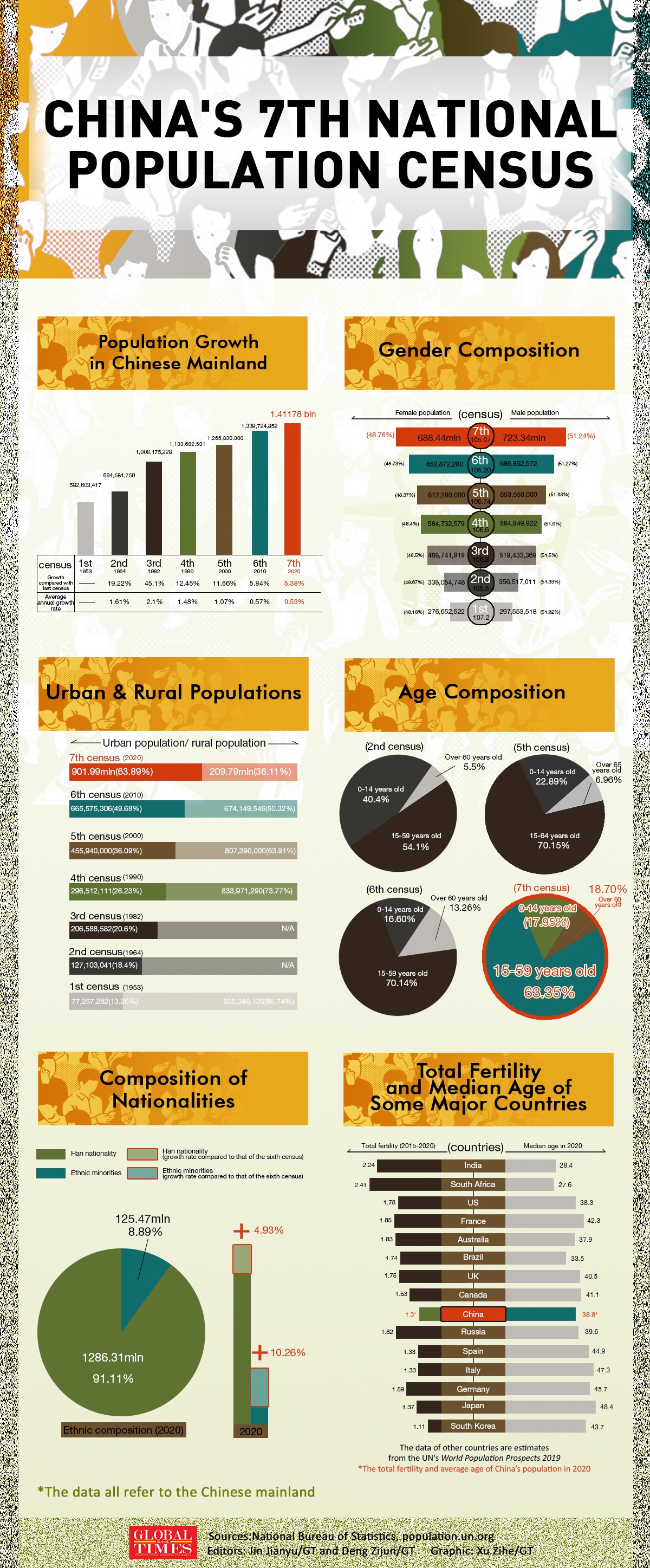Chinese mainland's population grows to 1.412 billion in 2020, but likely to ‘decline as early as 2022’

China's 7th National Population Census Infographic: Xu Zihe/GT
The population of Chinese mainland grew to 1.412 billion in 2020, up from 1.4 billion at the end of 2019, according to the results of its once-a-decade population census, which were released when China's population development entered a critical turning point with a rapidly aging population and population growth soon ending a five-decade trend of growth.
Chinese observers said that the seventh national population census results, revealing that China's population is not just declining in the future but also its demographic structure is deteriorating with a growing aging population, will serve as an important reference for China's population and economic policy adjustment as well as plans to put off retirement, which may come in the next year or two.
The figures showed that China's population is growing more slowly than in the past. From 2010 to 2020, the Chinese mainland's population grew by 5.38 percent, but from 2000 to 2010, the Chinese mainland's population grew from 1.26 billion to 1.34 billion, an increase of 5.84 percent, according to the results of the sixth population census.
Chinese demographers said that although China reported population growth in 2020, the general declining trend was inevitable, and China's population is likely to start to decline as early as 2022.
He Yafu, an independent demographer, told the Global Times that there is no doubt that China will fully lift family planning policy in the near future to cope with the declining birth rate and China is likely to remove its family planning policy as early as this autumn during the sixth plenary session of the 19th Central Committee of the Communist Party of China (CPC).
Removing family planning policy will not be enough to avert a fall in China's total population, or prevent China from becoming another Japan, demographers said, noting that China should come up with more measures to encourage childbirth, such as subsidizing couples who choose to have more than one baby.
The result of the number of people in different age groups revealed that the number of China's labor force shrank more rapidly in the past decade while the aging population continued to deepen.
The proportion of people aged 14 and younger in the Chinese mainland was 17.95 percent, up by 1.35 percentage points from that in 2010 census.
The number of people aged between 15 and 59 was 894 million, down by 6.79 percentage points from that in the 2010 census.
The number of people aged 60 and above grew to 264 million , up from 177.6 million in the 2010 census, and the number of people aged 65 and above grew to 190 million, up from 118.8 million in the 2010 census.
The elderly population figures will be a significant reference for authorities when making China's retirement plan, He said.
China is eyeing a progressive, flexible and differentiated path to raising the retirement age. According to the Outline of the 14th Five-Year Plan (2021-2025) for National Economic and Social Development and the Long-Range Objectives Through the Year 2035, China will take small steps to raise the retirement age. It will also implement flexible, tailored policies for different groups, consider all factors, and make overall plans.
The National Bureau of Statistics released the results of the seventh national population census on Tuesday, one month later than its previously-scheduled release period.
Chinese observers said the delay of the release—which was rare—was probably because the seventh population census included a lot more detailed information compared to the sixth census, requiring extra time.
The main figures of the sixth census were released on April 28, 2011, and the detailed and complete result was released in April 2012.


